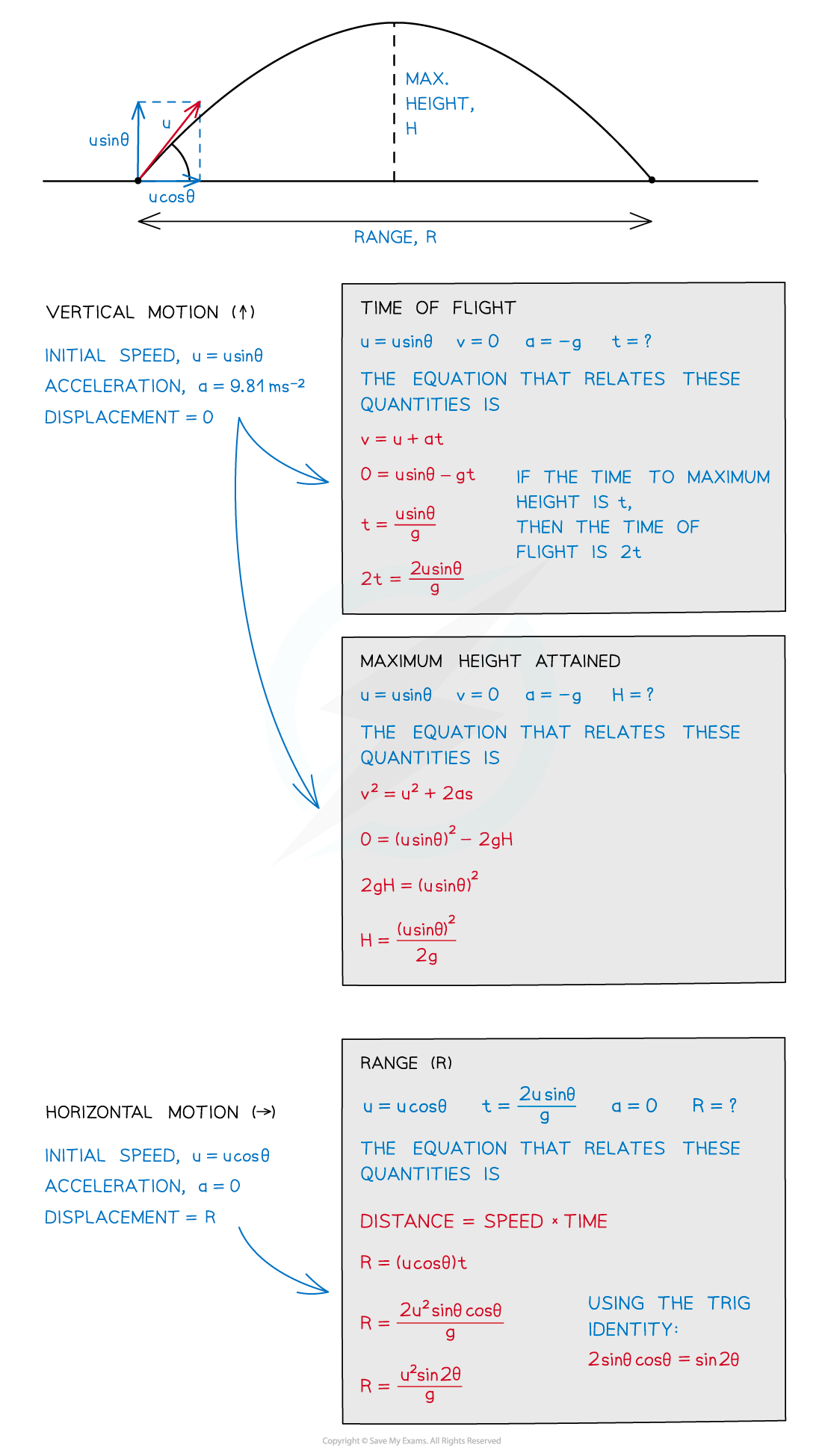Projectile Motion (AQA A Level Physics) : Revision Note
Projectile Motion
What is a projectile?
A projectile is a particle moving freely (non-powered), under gravity, in a two-dimensional plane
Examples of projectile motion include throwing a ball, jumping off a diving board and hitting a baseball with a baseball bat

Examples of objects in a projectile motion trajectory
An object is sent into a projectile motion trajectory with a resultant velocity, u at an angle, θ to the horizontal
Examples of this include a ball thrown from a height and a cannonball launched from a cannon

An object in a projectile motion trajectory has a resultant velocity at a given angle to the horizontal ground
Some key terms to know, and how to calculate them, are:
Time of flight (total time): how long the projectile is in the air.
For typical projectile motion, the time to the maximum height is half of the total time
Maximum height attained: the height at which the projectile is momentarily at rest
This is when the vertical velocity component = 0
When the projectile is released and lands on the ground the projectile is at its maximum height when half of its total time has elapsed
Range: the horizontal distance travelled by the projectile

An object in projectile motion will have a vertical velocity of zero at maximum height when half the time has elapsed
Horizontal and Vertical Components
The trajectory of an object undergoing projectile motion consists of a vertical component and a horizontal component
These quantities are independent of each other
Displacement, velocity and acceleration are all vector quantities that are different in both components
They need to be evaluated separately using the SUVAT Equations
| Horizontal Component | Vertical Component |
Displacement |
| Maximum height is at the top of the motion when half the time has elapsed |
Velocity | Constant | Zero at maximum height |
Acceleration | Zero (because velocity remains constant) | Acceleration of free fall, g = 9.8 ms−2
|

Acceleration and horizontal velocity are always constant whilst vertical velocity changes
The resultant velocity of an object in projectile motion can be split into its horizontal and vertical vector components using trigonometry where:
Vertical component = opposite side of the projectile triangle
opposite = sinθ × hyp = u sinθ
Horizontal component = adjacent side of the projectile triangle
adjacent = cosθ × hyp = u cosθ

The resultant velocity at an angle to the horizontal can be resolved using trigonometry into the horizontal and vertical components
It can be helpful to see how different equations calculate different quantities using SUVAT equations
Examples of obtaining the equations for total time, maximum height and range are shown below

Examples of using SUVAT equations to determine the time of flight, maximum height and range of a projectile
The effects of air resistance on projectile motion
Any object moving through the air experiences air resistance which creates a force of drag
This is caused by friction between the air molecules and the object
The drag force:acts in the opposite direction to the direction of motion of the object
Its horizontal component reduces its horizontal velocity and its range
Its vertical component reduces its maximum height and causes a steeper gradient as it falls back to earth
Factors that affect the motion of an object through a fluid
A fluid is a term used to describe a liquid and a gas
The mass and surface area of an object are the two main factors that affect the motion of an object:
An object with a larger surface area will experience a larger air resistance
An object with a greater mass will have a greater weight
Solving problems with projectiles
You may be required to calculate the missing quantities from the following projectile motion scenarios:
Vertical projection
Horizontal projection
Projection at an angle, the most common scenario
Worked Example
To calculate vertical projection(free fall)
A science museum designed an experiment to show the fall of a feather in a vertical glass vacuum tube.
The time of fall from rest is 0.5 s.

What it the length of the tube, L?
Answer:

Worked Example
To calculate horizontal projection
A motorcycle stunt-rider moving horizontally takes off from a point 1.25 m above the ground, landing 10 m away as shown.
What was the speed at take-off?

Answer:

Worked Example
To calculate projection at an angle
A ball is thrown from a point P with an initial velocity u of 12 m s-1 at 50° to the horizontal.
What is the value of the maximum height at Q?

Answer:

Examiner Tips and Tricks
Make sure you remember the following:
Deceleration is negative as the object rises
sin θ is used for the vertical component of velocity and cos θ the horizontal component
Units should be converted into standard units such a m, s, ms−1 and ms−2
At the top of the motion, at maximum height, the vertical velocity is zero

You've read 0 of your 5 free revision notes this week
Sign up now. It’s free!
Did this page help you?
